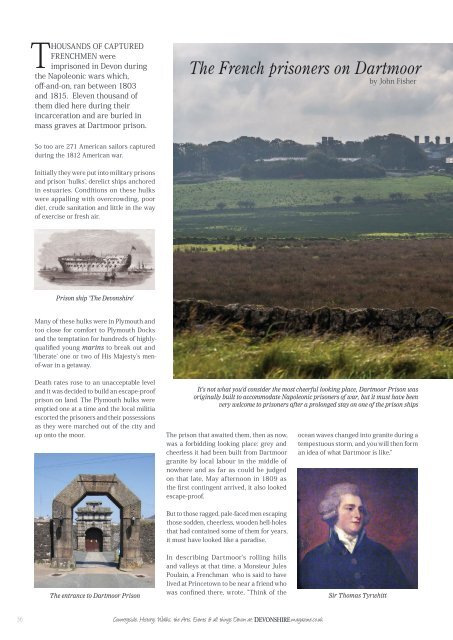Devonshire August and September 2017
You also want an ePaper? Increase the reach of your titles
YUMPU automatically turns print PDFs into web optimized ePapers that Google loves.
THOUSANDS OF CAPTURED<br />
FRENCHMEN were<br />
imprisoned in Devon during<br />
the Napoleonic wars which,<br />
off-<strong>and</strong>-on, ran between 1803<br />
<strong>and</strong> 1815. Eleven thous<strong>and</strong> of<br />
them died here during their<br />
incarceration <strong>and</strong> are buried in<br />
mass graves at Dartmoor prison.<br />
The French prisoners on Dartmoor<br />
by John Fisher<br />
So too are 271 American sailors captured<br />
during the 1812 American war.<br />
Initially they were put into military prisons<br />
<strong>and</strong> prison ‘hulks’, derelict ships anchored<br />
in estuaries. Conditions on these hulks<br />
were appalling with overcrowding, poor<br />
diet, crude sanitation <strong>and</strong> little in the way<br />
of exercise or fresh air.<br />
Prison ship 'The <strong>Devonshire</strong>'<br />
Many of these hulks were in Plymouth <strong>and</strong><br />
too close for comfort to Plymouth Docks<br />
<strong>and</strong> the temptation for hundreds of highlyqualified<br />
young marins to break out <strong>and</strong><br />
‘liberate’ one or two of His Majesty’s menof-war<br />
in a getaway.<br />
Death rates rose to an unacceptable level<br />
<strong>and</strong> it was decided to build an escape-proof<br />
prison on l<strong>and</strong>. The Plymouth hulks were<br />
emptied one at a time <strong>and</strong> the local militia<br />
escorted the prisoners <strong>and</strong> their possessions<br />
as they were marched out of the city <strong>and</strong><br />
up onto the moor.<br />
It's not what you'd consider the most cheerful looking place, Dartmoor Prison was<br />
originally built to accommodate Napoleonic prisoners of war, but it must have been<br />
very welcome to prisoners after a prolonged stay on one of the prison ships<br />
The prison that awaited them, then as now,<br />
was a forbidding looking place: grey <strong>and</strong><br />
cheerless it had been built from Dartmoor<br />
granite by local labour in the middle of<br />
nowhere <strong>and</strong> as far as could be judged<br />
on that late, May afternoon in 1809 as<br />
the first contingent arrived, it also looked<br />
escape-proof.<br />
ocean waves changed into granite during a<br />
tempestuous storm, <strong>and</strong> you will then form<br />
an idea of what Dartmoor is like.”<br />
But to those ragged, pale-faced men escaping<br />
those sodden, cheerless, wooden hell-holes<br />
that had contained some of them for years,<br />
it must have looked like a paradise.<br />
The entrance to Dartmoor Prison<br />
In describing Dartmoor’s rolling hills<br />
<strong>and</strong> valleys at that time, a Monsieur Jules<br />
Poulain, a Frenchman who is said to have<br />
lived at Princetown to be near a friend who<br />
was confined there, wrote, ”Think of the<br />
Sir Thomas Tyrwhitt<br />
36<br />
Countryside, History, Walks, the Arts, Events & all things Devon at: DEVONSHIRE magazine.co.uk

















